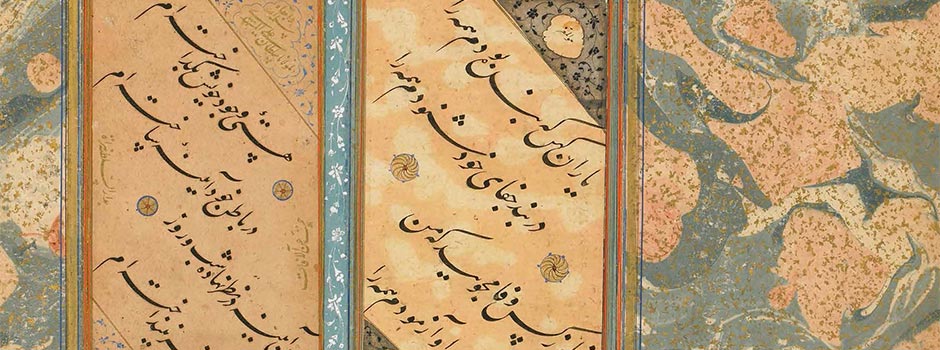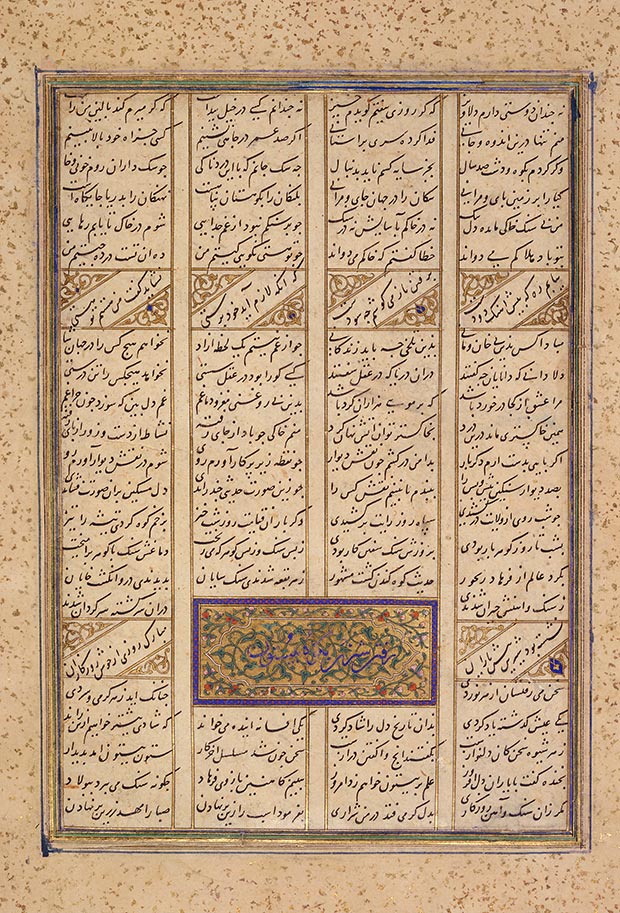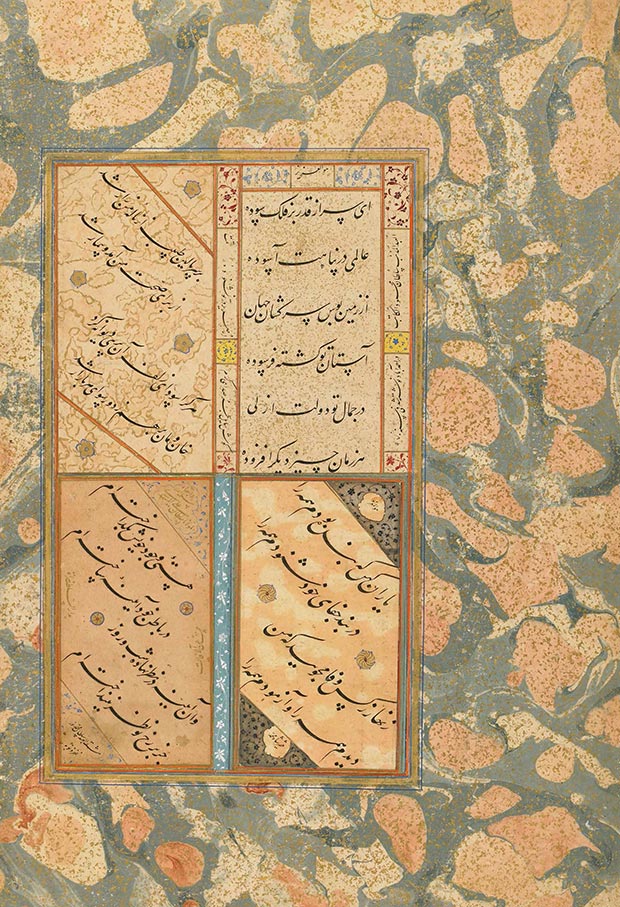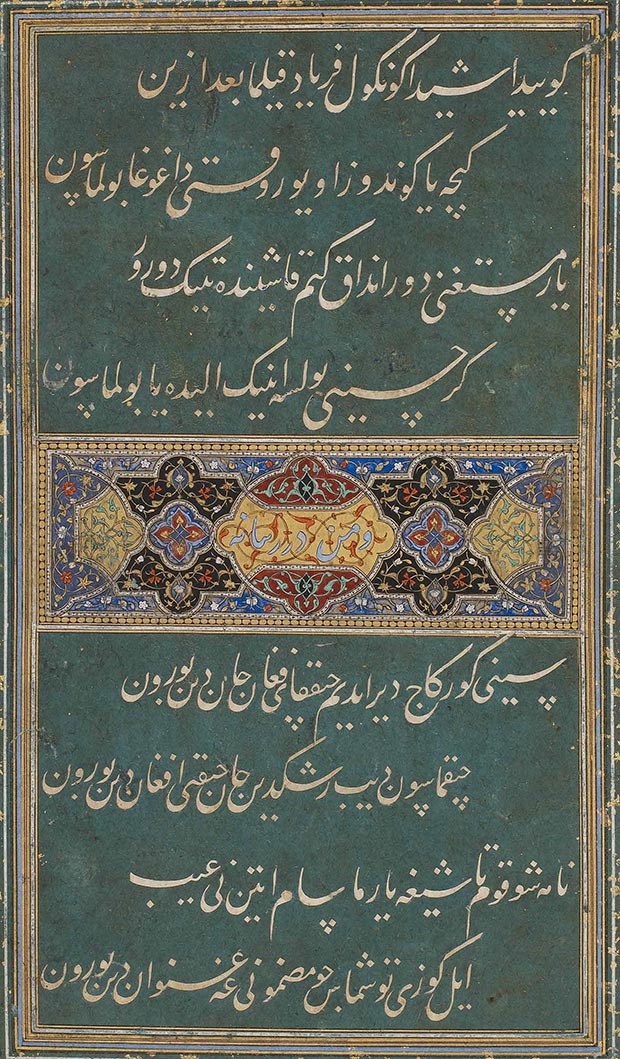
ART EXHIBITION (September 13, 2014 - March 22, 2015) Words Take Flight in Persian Calligraphy at Sackler Gallery
Aug 17, 2014 Exhibition

During a prolific 200-year period in the 14th–16th centuries, four master calligraphers invented one of the most aesthetically refined forms of Persian culture: nasta‘liq, a type of calligraphy so beautiful that for the first time the expressive form of the words eclipsed their meaning. 'Nasta‘liq: The Genius of Persian Calligraphy,' opening Sept. 13 at the Smithsonian’s Arthur M. Sackler Gallery, displays 20 rarely seen masterworks created by the script’s greatest practitioners, tracing its evolution from a simple style of writing to a potent form of artistic expression.
This is the first exhibition ever to focus specifically on nasta‘liq, which was used primarily to write poetry, Persia’s quintessential form of literature. With sinuous lines, short vertical strokes and an astonishing sense of rhythm, the script was an immediate success and was rapidly adopted throughout the Persian-speaking world from Turkey to India. The exhibition shows how generations of itinerant calligraphers, bound by the master-pupil relationship, developed, enhanced and spread nasta‘liq between major artistic centers.
.jpg) Folio of calligraphy, signed by Mir Imad Hasani / Iran, probably Isfahan, Safavid period, dated 1611–12 (1020 AH). Borders: India, Mughal period, ca. 1750. Ink, opaque watercolor, and gold on paper. Purchase: Freer Gallery of Art F1942.15b / Photo courtesy of Arthur M. Sackler Gallery
Folio of calligraphy, signed by Mir Imad Hasani / Iran, probably Isfahan, Safavid period, dated 1611–12 (1020 AH). Borders: India, Mughal period, ca. 1750. Ink, opaque watercolor, and gold on paper. Purchase: Freer Gallery of Art F1942.15b / Photo courtesy of Arthur M. Sackler Gallery
 Khusraw u Shirin by Nizami, signed by Mir Ali Tabrizi / Iran, Tabriz, Jalayirid period, ca. 1400. Ink, opaque watercolor, and gold on paper. Purchase Freer Gallery of Art F1931.29 folios 50–51 / Photo courtesy of Arthur M. Sackler Gallery
Khusraw u Shirin by Nizami, signed by Mir Ali Tabrizi / Iran, Tabriz, Jalayirid period, ca. 1400. Ink, opaque watercolor, and gold on paper. Purchase Freer Gallery of Art F1931.29 folios 50–51 / Photo courtesy of Arthur M. Sackler Gallery
"Nasta‘liq represents one of the most accomplished forms of Persian art, developed at a time of cultural and artistic effervescence in Iran," said Simon Rettig, exhibition curator and curatorial fellow at the Freer and Sackler galleries. "In a sense, it became the visual embodiment of the Persian language enthusiastically embraced from Istanbul to Delhi and from Bukhara to Baghdad."
Each of the four masters featured in the exhibition—Mir Ali from Tabriz (active ca. 1370–1410), Sultan Ali from Mashhad (d. 1520), Mir Ali from Herat (d. 1545) and Mir Imad Hasani from Qazvin (d. 1615)—further evolved the nasta‘liq style, intentionally slanting the script for dramatic effect, modulating lines to balance fluidity and discipline, and adding delicate, twisting flourishes. Often attached to royal and princely courts, many calligraphers were the celebrities of their time, and visitors will learn fascinating anecdotes of fame and rivalry.
 Album folio, signed by Sultan Ali Mashhadi / Iran, Mashhad, or Afghanistan, Herat, Safavid period, ca. 1510–15. Paintings ascribed to Muhammad Sadiqi and Muhammad Qasim. Iran, probably Qazvin, Safavid period, ca. 1590. Ink, opaque watercolor, and gold on paper. Purchase—Smithsonian Unrestricted Trust Funds, Smithsonian Collections Acquisition Program, and Dr. Arthur M. Sackler S1986.305 / Photo courtesy of Arthur M. Sackler Gallery
Album folio, signed by Sultan Ali Mashhadi / Iran, Mashhad, or Afghanistan, Herat, Safavid period, ca. 1510–15. Paintings ascribed to Muhammad Sadiqi and Muhammad Qasim. Iran, probably Qazvin, Safavid period, ca. 1590. Ink, opaque watercolor, and gold on paper. Purchase—Smithsonian Unrestricted Trust Funds, Smithsonian Collections Acquisition Program, and Dr. Arthur M. Sackler S1986.305 / Photo courtesy of Arthur M. Sackler Gallery
 Album folio / Signed by Sultan Mahmud, Shah Muhammad, and Sultan Muhammad Nur. Historic Iran, present-day Afghanistan, Herat and Ahmedabad, Safavid period, 16th century. Ink, opaque watercolor, and gold on paper. Purchase—Smithsonian Unrestricted Trust Funds, Smithsonian Collections Acquisition Program, and Dr. Arthur M. Sackler S1986.349 / Photo courtesy of Arthur M. Sackler Gallery
Album folio / Signed by Sultan Mahmud, Shah Muhammad, and Sultan Muhammad Nur. Historic Iran, present-day Afghanistan, Herat and Ahmedabad, Safavid period, 16th century. Ink, opaque watercolor, and gold on paper. Purchase—Smithsonian Unrestricted Trust Funds, Smithsonian Collections Acquisition Program, and Dr. Arthur M. Sackler S1986.349 / Photo courtesy of Arthur M. Sackler Gallery
Mastering nasta‘liq can take a lifetime, but it remains the most popular form of Persian calligraphy today. A demonstration video in the exhibition, along with calligraphic tools and accessories, shows how techniques developed more than 500 years ago are still practiced by contemporary calligraphers. Primarily drawn from the collections of the Freer and Sackler galleries, highlights include the only known signed work by the “inventor†of nasta‘liq Mir Ali from Tabriz, two folios from a collection of poetry by the late 15th-century ruler Sultan Husayn Bayqara and sumptuous illuminated pages from imperial Mughal albums.
 Folio from a Divan by Sultan Husayn Bayqara, attributed to Sultan Ali Mashhadi / Historic Iran, present-day Afghanistan, Herat, Timurid period, ca. 1490. Ink, opaque watercolor, and gold on paper. Purchase: Freer Gallery of Art F1929.66 / Photo courtesy of Smithsonian’s Arthur M. Sackler Gallery
Folio from a Divan by Sultan Husayn Bayqara, attributed to Sultan Ali Mashhadi / Historic Iran, present-day Afghanistan, Herat, Timurid period, ca. 1490. Ink, opaque watercolor, and gold on paper. Purchase: Freer Gallery of Art F1929.66 / Photo courtesy of Smithsonian’s Arthur M. Sackler Gallery
The exhibition will be on view through March 22, 2015.
Comments
Add a comment